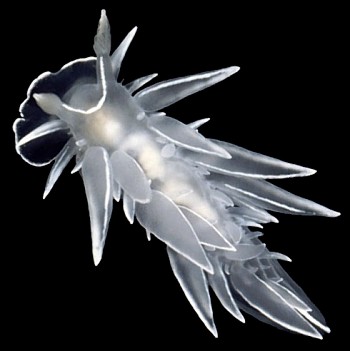
Dirona albolineata
MacFarland in Cockerell & Eliot, 1905
Order: NUDIBRANCHIA
Suborder: ARMININA
Family: Dironidae
DISTRIBUTION
San Diego, California to Alaska.
PHOTO
Cape Arago, Oregon, USA. 35 mm long, collected from the rocky intertidal. Photo: Jeff Goddard.
This delicate and translucent arminacean is an opportunistic predator capable of feeding on a wide variety of prey, including arborescent and foliose bryozoans, small prosobranchs and crustaceans, hydroids and ascidians (Robilliard, 1971; Goddard, 1998, personal observations). Robilliard (1971) observed it tending to specialize on either bryozoans or small snails in two different habitats, depending on which prey item was most abundant.
Dirona albolineata ranges from San Diego, California to Alaska and reaches 180 mm in length (Behrens, 1991).
See message on copepod parasites.
References:
• Behrens, D.W. 1991. Pacific Coast Nudibranchs. Sea Challengers: Monterey, California.
• Goddard, J.H.R. 1998. A summary of the prey of nudibranch molluscs from Cape Arago, Oregon. Opisthobranch Newsletter, 24: 11-14.
• Robilliard, G.A. (1971) Predation by the nudibranch Dirona albolineata on three species of prosobranchs. Pacific Science, 25: 429-435.
[Prepared by Jeff Goddard]
Authorship detailsGoddard, J.H.R., 2000 (June 16) Dirona albolineata MacFarland in Cockerell & Eliot, 1905. [In] Sea Slug Forum. Australian Museum, Sydney. Available from http://www.seaslugforum.net/find/diroalbo
Related messages
Re: Dirona albolineata & D. pellucida interaction
April 8, 2010
From: Jackie Hildering
Concerning message #23435:
Thanks you Bill,
For what it is worth, I believe very strongly that the orange animal is not a colour variant of Dirona albolineata. I believe it to be Dirona pellucida.
Note the white spotting, the white tapered line leading up the cerata and the more bulbous shape of the cerata.
None of these characteristics are in the more orange variant of D. albolineata in message #23212
Very best wishes and thank you,
Jackie
earthlingenterprises@telus.net
Hildering, J., 2010 (Apr 8) Re: Dirona albolineata & D. pellucida interaction. [Message in] Sea Slug Forum. Australian Museum, Sydney. Available from http://www.seaslugforum.net/find/23460Dear Jackie,
Thanks for the fast reply. I was really asking a question about how you identify these two species. Since I have no personal experience with these two species, I am not really in the position to comment on your identifications. I could see the characteristic white lines etc on the white D. albolineata but couldn't see the edge of the oral veil in the orange one so couldn't really check if it was D. albolineata. I thought white spots were characteristic of D. pellucida but then found the animal identified as D. albolineata [message #18951] with white spots so was a bit puzzled.
It is an interesting observation and I am sure next time you see a similar occurrence you will give them a gentle prod to see if they are breaking the species' rules or just passing by very closely
Best wishes,
Bill Rudman
Dirona albolineata & D. pellucida interaction
April 8, 2010
From: Jackie Hildering
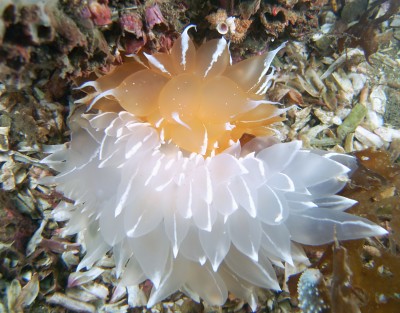
Wanted to share this observation of the two Dirona species [Dirona albolineata & D. pellucida] interacting. Mistaken identity? They do appear to be lining up right side to right side.
Locality: Port Hardy , 63 feet , British Columbia, CANADA, Pacific Ocean, 02 April 2010, Wall . Length: 12 cm. Photographer: Jackie Hildering.
Jackie Hildering
earthlingenterprises@telus.net
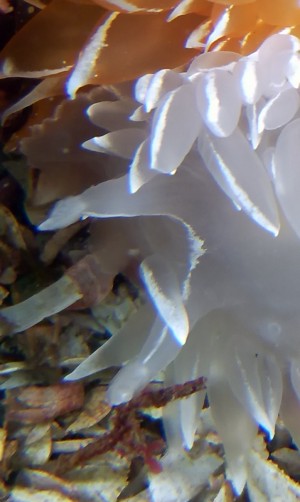


Dear Jackie,
In your last message on Dirona albolineata [#23212] I noticed the orange tinge on one of the animals, which is part of that species' colour variability but I also noticed the larger white animal had no white line bodering the head and foot, which I thought was one of the characters distinguishing this species from D. pellucida.
There are quite a few messages on the Forum showing colour variability in this species. Unfortunately I can't see any of these details in the orange animal. Far be it from me to query your identification but how do you distinguish an orange D. pellucida from the orange form of D. albolineata. In an earlier message [#18951] it seems that D. albolineata can sometimes have the white spots I thought were characteristic of D. pellucida.
If these two animals were mating then we need a closer look at these two species. I think this is the situation where it would have been acceptable to give them a gentle 'nudge' just to see what they were up to.
Best wishes,
Bill Rudman
Re: Dirona albolineata mating and spawning
April 6, 2010
From: Jacqui Engel & Jackie Hildering
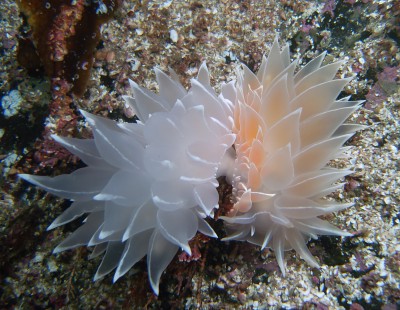
Concerning message #20661:
More mating of Dirona albolineata. Remarkable right now how 10s of the species seem to be gathering at this site (between about 20 and 40'). The photos reveal that we found two pairs mating.
Locality: Port Hardy , 20 feet, British Columbia, CANADA, Pacific Ocean, 02 February 2010, Wall . Length: 6 inches. Photographer: Jacqui Engel & Jackie Hildering.
Jacqui Engel & Jackie Hildering
earthlingenterprises@telus.net

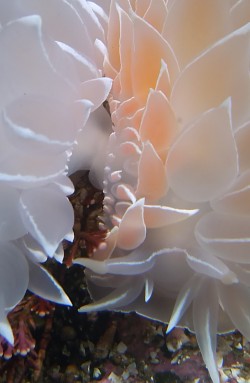
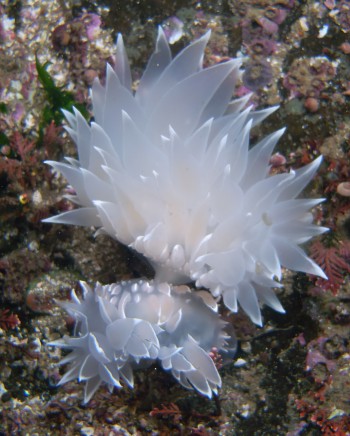
Dear Jacqui and Jackie,
Thanks for these photos.
Best wishes,
Bill Rudman
Re: Dirona albolineata eggs?
August 26, 2009
From: Jackie Hildering & Glen Miller

Concerning message #20169:
Two years later, and a lot smarter, I realize that the eggs masses I sent as an August 6th, 2007 post are not those of Dirona albolineata.
Found this mass near the specimen I photographed and they appear similar to those in message #20661 where the contributor was lucky enough to find the animal's laying the mass.
Thought it might be interesting too to see what the specimen appeared to be targeting. Leaf crust bryozoan (Dendrobeania lichenoides) and white tuft bryozoan (Crisia species)?
Locality: Mist Isle, 27 feet , British Columbia, CANADA, Pacific Ocean, 20 June 2009, Wall . Length: 11cm. Photographer: Jackie Hildering.
Jackie Hildering and Glen Miller
earthlingenterprises@telus.net
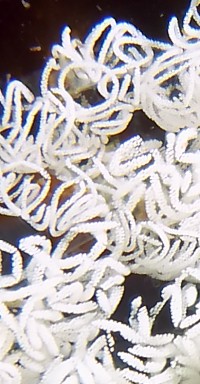


Thanks Jackie and Glen,
Best wishes,
Bill Rudman
Infested Dirona albolineata from British Columbia
November 25, 2008
From: Marli Wakeling
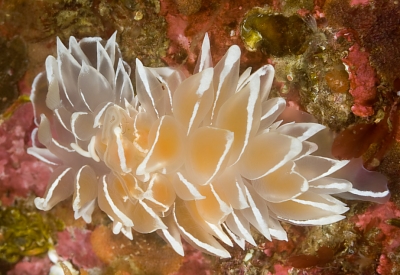

Concerning message #22030:
Dear Bill,
While going through some photos from earlier this year, I found this Dirona albolineata with a several copepod egg sacs and some other infestation that looks like a worm or leech. Do you have any idea what this creature is, and if so, is it a parasite?
Locality: Barkley Sound, 20 m., British Columbia, Canada, Pacific, 19 May 2008, Rocky Reef. Length: 10 cm.. Photographer: Marli Wakeling.
Cheers,
Marli Wakeling
scubamarli@gmail.com
Wakeling, M., 2008 (Nov 25) Infested Dirona albolineata from British Columbia. [Message in] Sea Slug Forum. Australian Museum, Sydney. Available from http://www.seaslugforum.net/find/22038Hi Marli,
Well the endoparasitic copepod, Ismaila is pretty obvious, with its white sausage-shaped egg masses, but I have no clue what the worm-like critter (assuming it is a critter) is. We'll have to throw this out to all of the Forum's readers for ideas.
Concerning the copepod, an interesting paper was presented two weeks ago in Vancouver, BC, at the Western Society of Naturalists annual meeting by M. Wolf & C.M. Young from the Oregon Institute of Marine Biology, Univ. of Oregon. Its title "Castrator or Constraint? Impacts of the parasitic copepod Ismaila belciki on the reproductive output of its nudibranch host, Janolus fuscus". Other species of Ismaila are known to destroy the gonads of their hosts. The authors found that the Ismaila belciki infects over 60 percent of the slugs in Oregon, but because egg production is not effected they conclude it is not a castrator.
Best wishes,
Dave Behrens
Feeding of Dirona albolineata
March 17, 2008
From: Jackie Hildering & Glen Miller

Enjoyed finding this specimen feeding on hydroids on the outside of what I think is Spiochaetopterus costarum. We've previously submitted photos (message 12533) of Flabellina triophina feeding on the same prey but misidentified the worm species and initially thought the nudibranch was feeding on the worm!
Locality: Bear Cove, 40 feet, British Columbia, Canada, Pacific Ocean, 27 October 2007, Sandy bottom. Length: 13 cm. Photographer: Jackie Hildering.
Jackie Hildering and Glen Miller
earthlingenterprises@telus.net
Hildering, J. & Miller, G., 2008 (Mar 17) Feeding of Dirona albolineata. [Message in] Sea Slug Forum. Australian Museum, Sydney. Available from http://www.seaslugforum.net/find/21138Hi Jackie and Glen,
What a fantastic photo. Beautiful. You can really see the smooth lines of the frontal veil and the angular shape of the cerata.
I am not sure I can conclude that this specimen is actively feeding or just out for a cruise. Without a shot of an open mouth, or some gut analysis, this will have to remain a mystery.Thanks for sharing,
Dave Behrens
Re: Parasites on Dirona albolineata
November 12, 2007
From: J. Hildering & G. Miller
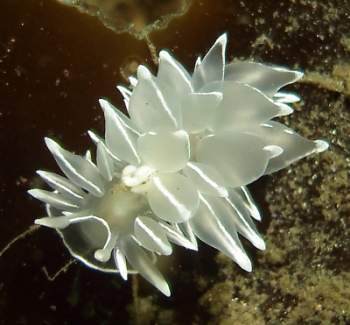
Concerning message #3230:
This individual too appears to be serving as host to a parasite.
Locality: Bear Cove - Port Hardy, 45', British Columbia, Canada, Pacific Ocean, 29 September 2007, Wall. Length: 7 cm. Photographer: Jackie Hildering.
Jackie Hildering and Glen Miller
earthlingenterprises@telus.net
Hildering, J. & Miller, G., 2007 (Nov 12) Re: Parasites on Dirona albolineata. [Message in] Sea Slug Forum. Australian Museum, Sydney. Available from http://www.seaslugforum.net/find/20868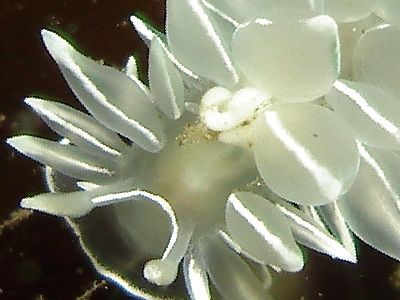
Hi Jackie and Glen,
Absolutely. The white string is the egg mass of a parasitic copepod. The copepods body is inside the body cavity.
Best wishes,
Dave Behrens
Dirona albolineata mating and spawning
September 10, 2007
From: Marcos Perreau Guimaraes

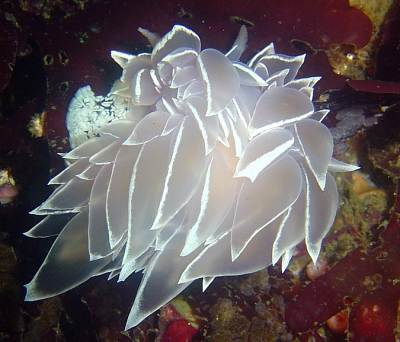
Hi Bill,
Diving Arena Rock, California, near the rock and at a depth of about 60', I came into a groups of dozens of Dirona albolineata, a few mating or spawning eggs. All the mating pairs I saw had one white and one brown color variation. Here a few pictures.
Locality: Arena Rock, N of Point Arena, 20 m, [60 ft], California, USA, Pacific NW, 02 September 2007, Offshore pinnacle. Length: most about 50 mm. Photographer: Marcos Perreau Guimaraes.
Cheers,
Marcos.
montereyunderwater@gmail.com
Perreau Guimaraes, M., 2007 (Sep 10) Dirona albolineata mating and spawning. [Message in] Sea Slug Forum. Australian Museum, Sydney. Available from http://www.seaslugforum.net/find/20661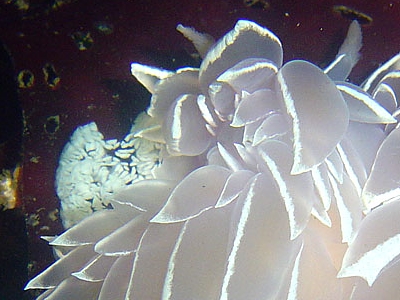
Hi Marcos,
Beautiful photos. It is great to get the eggs with the animal so we know their ID. Concerning the mixed mating of different colored individuals, this is likely to be just a coincidence.
Thanks for sharing,
Dave Behrens
Re: Colour variation in Dirona albolineata
August 24, 2007
From: Dave Washburn
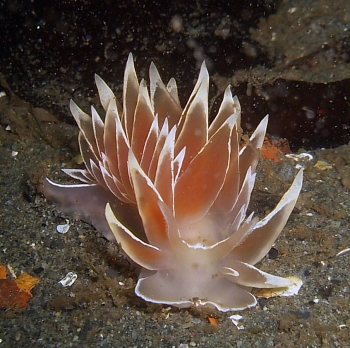
Concerning message #16456:
My daughter and I found this Dirona albolineata on the barge at Salt Water State Park in Puget Sound. I got extremely excited because I thought it was a Golden Dirona, which we had never seen before. I was so sure I didn't bother to consult Dave Behrens' book until someone on another forum pointed out my mistake. Oh well, that's what I get for assuming. I had no idea these guys could develop such an intense orangish color. It was amazing.
Locality: Salt Water State Park, 40 ft, Washington, USA, Puget Sound, 15 August 2007, Found on the side of a piece of old wreck. Length: 2.5 inches. Photographer: Malinda Washburn.
Dave Washburn
dwashbur@nyx.net
David L. Washburn, 2007 (Aug 24) Re: Colour variation in Dirona albolineata. [Message in] Sea Slug Forum. Australian Museum, Sydney. Available from http://www.seaslugforum.net/find/20504Dear Dave,
No problem, we have all made a miss-ID or 20 in our lives. Yes, this Dirona is quite variable in ground color as show in Andy & Bernie's new book. You were obviously thrown off as your specimen just happens to be really dark. In the future, the main external cues are that Dirona albolineata has a bright white line connecting the tips of the rhinopores (most obvious between the bases of the rhinophores), and a white line along the edge of the foot (most specimens, not yours here) and frontal veil (all specimens). Dirona pellucida has neither. And, keep that book handy.
Thanks for sharing,
Dave Behrens
Mating pair of Dirona albolineata
June 5, 2007
From: Daniel Hershman

Dear Bill
I found this mating pair of Dirona albolineata while doing a shallow dive at Edmonds Underwater Marine Park, Washington State.
Locality: Edmonds Underwater Marine Park, 25 feet, WA, United States, Pacific, 27 May 2007, Sandy slope. Length: 1 inch. Photographer: Daniel Hershman.
Daniel Hershman
dphershman@comcast.net
Hershman, D.P., 2007 (Jun 5) Mating pair of Dirona albolineata. [Message in] Sea Slug Forum. Australian Museum, Sydney. Available from http://www.seaslugforum.net/find/19961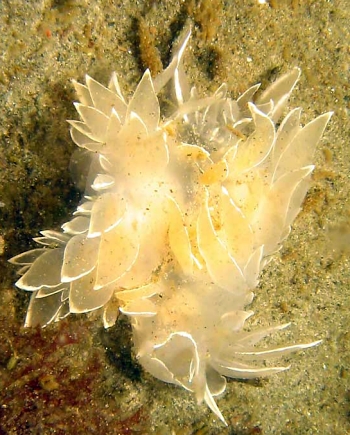
Hi Dan,
It certainly appears that your pair are mating, juxtaposed head to tail. Can't see the genitalia, but I'm they are in there somewhere.
It is interesting that up here in the State of Washington, it is common to find large specimens out on sandy slopes, with not the slightest source of bryozoan prey to be found. Farther south in California this would be a very unusual observation. Down there this species is always near its prey.
Thanks for sharing,
Dave Behrens
Unknown White Nudibranch..looks like an angel!
December 8, 2006
From: Sandy Grummon

On August 9, 2006 my husband, two friends and I were tide-pooling at Sisters Rocks on the southern Oregon coast (west coast of U.S.), about 50 miles north of the California border. It was 6:50 a.m. during a good low tide (-1.4. We were in an area of rocks, dense kelp and had been seeing dozens of sunflower stars, gumboot chitons, red sea cucumbers. We spotted a white nudibranch with cerata that looked more like little "wings". The wings looked translucent but the outer edges were a definite white.
Locality: Rocky intertidal area, 10", Oregon, United Statese, Pacific, 09 August 2006, Rocky intertidal. Length: Approximately 1"-1 1/4". Photographer: Bryan Grummon.
Sandy Grummon
sandygrumm@aol.com
Grummon, S., 2006 (Dec 8) Unknown White Nudibranch..looks like an angel!. [Message in] Sea Slug Forum. Australian Museum, Sydney. Available from http://www.seaslugforum.net/find/18951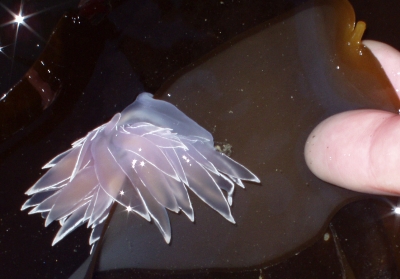
Hi Sandy,
Gorgeous creature. Your species is the arminacean nudibranch, Dirona albolineata (see Eastern Pacific Nudibranchs, page 101). Your specimen is pretty typical in size for this species which feeds on bryozoans.
Frank Mace McFarland named this species albolineata [= white lined] because of the while edge to the flattened cerata.
Best wishes,
Dave Behrens
Pink Dirona albolineata from Vancouver Island
July 7, 2006
From: Minette Layne
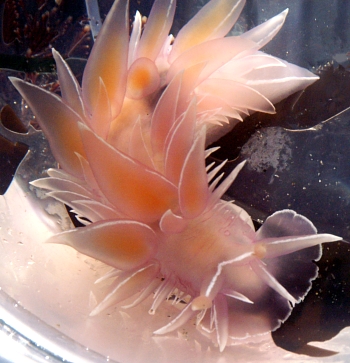

I found this pink Dirona albolineata crawling on kelp in a tide pool on Vancouver Island. I observed two rather interesting things when looking at this individual, and I'm hoping that someone on the forum will have more information about these two things.
First, when I gently coaxed the slug from the kelp into my observation bowl, it emitted some sort of white, milky substance into the water. It quickly dispersed and I was unable to get a picture of it. I assume this was some sort of defense mechanism, but I can't find reference to this behavior in the places I've looked.
Second, it had a round protuberance on the dorsum that I have not seen before. Although you cannot clearly tell this from the pictures, the round "thing" moved in the current as the cerata did, but it didn't seem to have the same white line as the cerata, and it definitely did not have the pointed shape that the cerata do. Do you have any idea what the round thing is?
Thank you very much for any information you can provide. And thank you for this terrific forum. I've learned a great deal here.
Locality: Point-No-Point, near Sooke, on Vancouver Island, Intertidal, British Columbia, Canada, Pacific Ocean, June 25, 2006, In kelp bed. Length: 8 cm. Photographer: Minette Layne.
Sincerely,
Minette Layne
minette_layne@hotmail.com
Layne, M.C., 2006 (Jul 7) Pink Dirona albolineata from Vancouver Island. [Message in] Sea Slug Forum. Australian Museum, Sydney. Available from http://www.seaslugforum.net/find/16991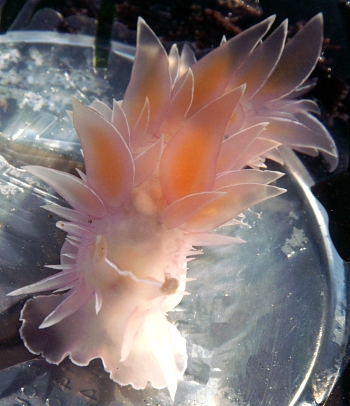
Hi Minette,
Good to hear from you again. Beautiful specimen, but obviously one that has been disturbed in the past, evidenced by the regenerating cerata on each side of the head. This is a clear example of autotomy, a reflex reaction where body parts are dropped to confuse an unwanted intruder.
The white substance you observed was likely a defence chemical as you suggest, however little if anything is known about this kind of a defensive strategy in this family. Certainly all other suborders of Nudibranchs secrete defensive chemicals. At the moment I am at a loss to think of an Arminacean that does.
The round projection you refer to (see Bill's circle on the close-up, above) is the anal papilla, which in this genus is located dorso-medially prior to the last cerata. This anatomical feature is similar in location to the anus found in the dorid nudibranchs, but differs from the lateral location of the anus in aeolids and dendronotids.
Thanks for sharing this,
Dave Behrens
Dirona from British Columbia
May 20, 2006
From: Avery Bartels

Hi,
This picture was taken at Bamfield Marine research Centre on the west coast of Vancouver Island in British Columbia, Canada. I am an amateur at best when it comes to nudibranchs and I cannot identify this individual. It looks very much like a White-lined Dirona [Dirona albolineata], but it is so orange that it has me torn between that and Gold Dirona [Dirona aurantia ]. Any ideas?
Locality: Bamfield, intertidal, B.C., Canada, Pacific Ocean, 30 April 2006, intertidal. Length: 2 inches. Photographer: Avery Bartels.
Avery Bartels
power2thepeaceful17@hotmail.com
Bartels, A., 2006 (May 20) Dirona from British Columbia. [Message in] Sea Slug Forum. Australian Museum, Sydney. Available from http://www.seaslugforum.net/find/16527
Hi Avery,
You have called it right - the white-lined Dirona. As indicated in a couple of previous messages Dirona albolineata varies in color from pure white to almost purple. Your brownish (gold) specimen is one of the common colours.
Your critter looks like it is taking protection during the low tide. When the water is in it was likely feeding on the branching bryozoan in the upper left portion of your photo. Good show.
Thanks
Dave Behrens
Colour variation in Dirona albolineata
April 28, 2006
From: Dave Behrens
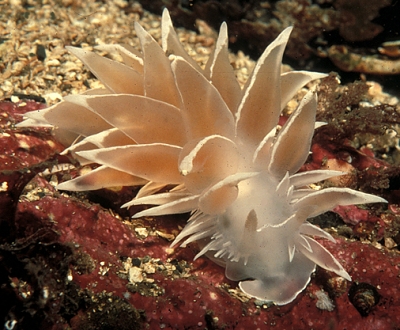
Hi Bill:
Just a couple of photos to add to Jan's note on colour variation in Dirona albolineata [message #15225 ]. This is a great example of just how wide colours can very and still be the same species.
The brown specimen was taken by Marc Chamberlain at the Channel Islands, southern California. The purple specimen was shot by Gordon Robilliard in the San Juan Islands, Washington.
Dave Behrens
dwbehrens@comcast.net
Behrens, D.W., 2006 (Apr 28) Colour variation in Dirona albolineata. [Message in] Sea Slug Forum. Australian Museum, Sydney. Available from http://www.seaslugforum.net/find/16456
Thanks Dave,
Bill Rudman
Colour phases of Dirona albolineata
April 28, 2006
From: Jan Kocian

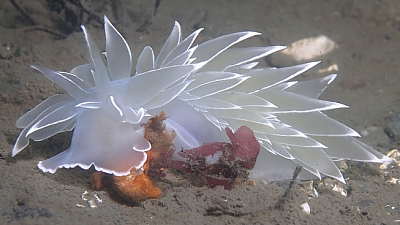
Hi Bill,
Enclosed photos of Dirona albolineata. I found about fifteen of them in an area of about seventy feet. I just finished checking zincs on boat's shaft and decided to see what lives on the muddy bottom below. I was surprised to find the white slugs cruising all over the fine muck, the only nice thing down there. Almost all of them were pure white, while the one I found on piling has cerata with yellowish tint . It seem to match the colour of the growth on the piling. I wonder how long the colouration lasts, do they revert to white again? The two slugs together seem to be in different stages of "yellowing" .
Locality: Whidbey Island, Puget Sound, WAshington, USA. NE Pacific Ocean. Depth: 15 feet. Length: 40 mm. 08 November 2005. muddy bottom. Photographer: Jan Kocian
Jan Kocian
honkoc@hotmail.com
Kocian, J., 2006 (Apr 28) Colour phases of Dirona albolineata. [Message in] Sea Slug Forum. Australian Museum, Sydney. Available from http://www.seaslugforum.net/find/15225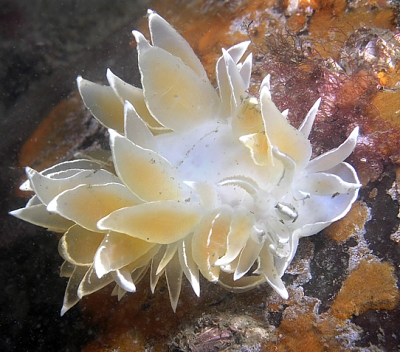
Hi Jan,
Thanks Jan. Yes you have captured examples of the sort of variability seen in many species of nudibranchs. Variation as seen here is often due to what and how much the individual has just eaten. Obviously your two animals here have either fed on different bryozoan species or the white one hasn't fed in awhile.
Dirona albolineata has been documented with even great color shifts. For those of you who still have a copy of the First Edition of Pacific Coast Nudibranchs kicking around, you will note on page 83, that Gordon Robilliard observed a dramatic purple specimen up in Puget Sound. Hard to explain that coloration.
Looks like the critter in the lower photo might belong on Bill's anomaly page, as it appears to have three rhinophores.
Best wishes,
Dave Behrens
Dirona albolineata and Melibe leonina
July 15, 2004
From: Jackie Hildering and Glen Miller

Dear Dr. Rudman,
The egg masses in the images I believe to be of Dirona albolineata and not of Melibe leonina. I saw many of the Dirona on Agarum fimbriatum [a brown algae often called Colander Weed] in the same position we found the eggs. We could not find an animal laying the eggs however.
Dive: Bear Cove, Northern Vancouver Island, British Columbia, Canada
Depth: 40’
Photographer: Glen Miller
Date: March 21st, 2004
Could you confirm if they are D. albolineata eggs? Also, in the images of the two different egg mass, there appears to be a common orange colouration in the background. What might this be?
And, finally, would anyone have a picture of Melibe leonina eggs? It is noteworthy that there are 1000s of M. leonina at this site from fall to spring but we don't believe we've ever seen any eggs.
Many thanks!
Jackie Hildering
earthent@telus.net
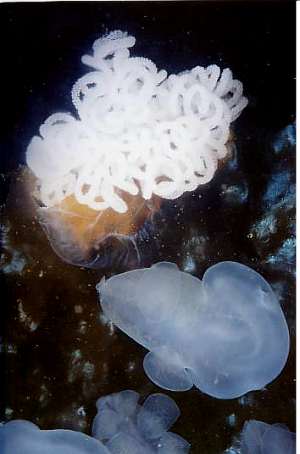
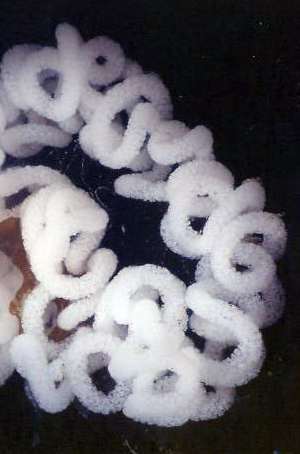
Dear Jackie & Glen,
I guess the animals in the bottom left photo with the egg ribbon are small Melibe. The eggs are definitely not Melibe. There is a photo of the eggs of M. leonina on the species Fact Sheet. It is a flattened ribbon much like a typical dorid egg ribbon. Other species of Melibe also have that shape [See message m9356].
It certainly looks like the descriptions of the egg ribbon of Dirona albolineata which has been described in some detail by Anne Hurst (1967) and O'Donoghue & O'Donoghue (1922). The O'Donoghue's mention it is often laid on kelp.
• Hurst, A. (1967) The egg masses and veligers of thirty northeast Pacific opisthobranchs. The Veliger, 9(3): 255-288, pls. 26-38.
• O'Donoghue, C. H. & O'Donoghue, E. 1922. Notes on the nudibranchiate Mollusca from the Vancouver Island region. II. The spawn of certain species. Transactions of the Royal Canadian Institute, 14(1):131-143, pl. 3.
Best wishes
Bill Rudman
Dirona albolineata from British Columbia
October 24, 2003
From: Bruce Wight
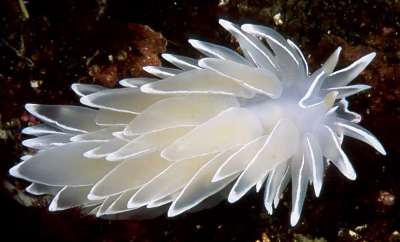
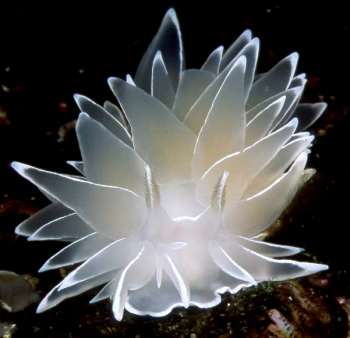
Dear Bill
Here are some photos of Dirona albolineata from our recent trip to British Columbia.
Johanna and I were up at the Northern end of Vancouver Island the first week of October diving around Port Hardy and Browning Pass, British Columbia. This was our first time diving in Canada.
In a separate message I have sent photos of Dirona aurantia.
Take care,
Bruce Wight
bwproductions@earthlink.net
Wight, B., 2003 (Oct 24) Dirona albolineata from British Columbia. [Message in] Sea Slug Forum. Australian Museum, Sydney. Available from http://www.seaslugforum.net/find/11285
Thanks Bruce,
Nice to get a closeup of the head
Best wishes
Bill Rudman
Dirona albolineata from Carmel, California
July 19, 2003
From: Clinton Bauder

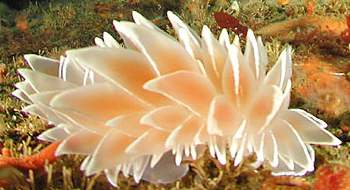
Hi Bill,
No big scientific discoveries here; just a bit of ego gratification if you will. Dive buddy Sami got this fun shot of me posing with a large Dirona albolineata on Sunday the 13th July just south of the Carmel Pinnacles, California. Depth was about 45m and the slug was about 12-15cm in length.
Photo © 2003 Sami Laine
Cheers,
Clinton
gecko1@apple.com
Bauder, C., 2003 (Jul 19) Dirona albolineata from Carmel, California. [Message in] Sea Slug Forum. Australian Museum, Sydney. Available from http://www.seaslugforum.net/find/10467Thanks Clinton & Sami,
If a bit of ego gratification keeps the photos and information flowing, then I'm all for it. It is certainly an impressive animal at this large size.
Best wishes,
Bill Rudman
Dirona albolineata from Canada
May 30, 2002
From: Linda Penny
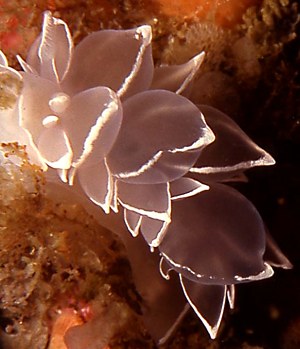
Dear Dr. Rudman,
This photo of Dirona albolineata was taken by Tracy Meintjies in British Columbia, Canada. Unfortunately that is all the information I have on the photo. As always I was using your site to ID the nudibranch and noticed that in the photos on your file the cerata (if that is the correct word for the spikes) are narrow and appear quite flat. In Tracy's photo they seem larger and inflated. Is it just the angle of the photo or is there a reason for this?
Many thanks
Linda Penny
lindapenny@netactive.co.za
Penny, L., 2002 (May 30) Dirona albolineata from Canada. [Message in] Sea Slug Forum. Australian Museum, Sydney. Available from http://www.seaslugforum.net/find/7067Dear Linda,
Please thank Tracy for this photo. Some species do seem to have more inflated cerata than others but I suspect that like many aeolids, the shape of the cerata is to some extent on the degree of contraction of the muscles in the ceratal wall. In an animal resting the relaxed muscle walls will allow the body fluid to to 'fatten' and shorten the cerata.
Best wishes,
Bill Rudman
Colour variation in Dirona albolineata
December 19, 2000
From: Marli Wakeling
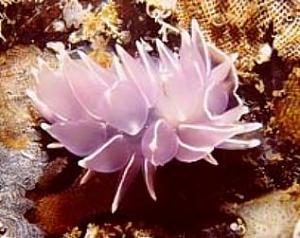
Hi Bill,
More photos from British Columbia, Canada.
Here is the colour variation of Dirona albolineata that I mentioned earlier. The photo was taken at Quadra Island, BC, in about 25 feet. I have only seen it the one time, back in 1998.
Marli
scubamarli@excite.com
Wakeling, M., 2000 (Dec 19) Colour variation in Dirona albolineata. [Message in] Sea Slug Forum. Australian Museum, Sydney. Available from http://www.seaslugforum.net/find/3311Thanks Marli,
Bill Rudman.
Colour variations of Dirona albolineata
October 22, 2000
From: Marli Wakeling

Dear Bill,
As promised in my earlier message, here is the golden colour variation of Dirona albolineata which is quite a common nudibranch in British Columbia waters. It also comes in lavender.
Marli Wakeling
scubamarli@excite.com
Wakeling, M., 2000 (Oct 22) Colour variations of Dirona albolineata. [Message in] Sea Slug Forum. Australian Museum, Sydney. Available from http://www.seaslugforum.net/find/3199Thanks Marli,
It is a beutiful animal.
Bill Rudman.
Variation in Dirona albolineata
September 24, 2000
From: Marli Wakeling
Hello again,
Just a note for those of you looking at these creatures. There are a number of colour variations to look for. The most common is translucent with white markings. However, I have also found commonly a pale orange and white variation and only once, a lavender one: quite gorgeous! I'll sift through my slides and see if I can find a photo.
Marli Wakeling
scubamarli@excite.com
Wakeling, M., 2000 (Sep 24) Variation in Dirona albolineata. [Message in] Sea Slug Forum. Australian Museum, Sydney. Available from http://www.seaslugforum.net/find/3053Dear Marti,
I hope you can find photos of these variants
Bets wishes,
Bill Rudman.
Information on Dirona albolineata
June 17, 2000
From: Jeff Goddard
Hi Bill,
Here is a photo and a short account of the feeding habits and range of Dirona albolineata MacFarland in Cockerell & Eliot, 1905 for the Forum.
Best wishes,
Jeff Goddard
goddard@lifesci.ucsb.edu
Goddard, J., 2000 (Jun 17) Information on Dirona albolineata. [Message in] Sea Slug Forum. Australian Museum, Sydney. Available from http://www.seaslugforum.net/find/2581Thanks Jeff,
Dirona certainly has some spectacular species.
Best wishes,
Bill Rudman.
